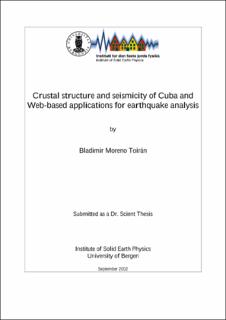Crustal structure and seismicity of Cuba and Web-based applications for earthquake analysis
Doctoral thesis
Permanent lenke
https://hdl.handle.net/11250/2712132Utgivelsesdato
2002Metadata
Vis full innførselSamlinger
- Department of Earth Science [1103]
Sammendrag
This thesis comprises six papers divided into two parts. Part I consist of four papers in which a study of the crust and seismicity of Cuba is presented. The main achievements in this part are: (1) A new Pwave velocity model for earthquake location using travel time inversion; (2) Crustal structure at seismic stations using Receiver Function Method; (3) A new attenuation relation for the frequencydependent quality factor Q using Coda-Q and spectral ratio method; (4) Estimation of the near-surface attenuation factor kappa; (5) A new local and coda magnitude scales; (6) Characterization of the seismicity and kinematics; and (7) Orientation of the principal stress axes using stress-inversion from earthquake focal-mechanisms. Most of these results are new for the region and offer a unique opportunity to develop new insight into the tectonic and kinematic regime along the southern Cuban margin. Part II includes two papers dealing with the design and implementation of Web-based applications in seismology. The first paper (Paper 5) proposes a Graphical User Interface (GUI) for retrieving and processing parametric and waveforms earthquake data through Internet. Here some aspects of the design are discussed like server-side and client-side processing, GUI and data-transfer speed. The second paper (Paper 6) proposes a relational Java database and a GUI for diagnosing active faults also through Internet. The system is based on distributed database technology, which means that the database can be distributed in several Internet-servers.
